|
 Phaeocollybia longipes Phaeocollybia longipes
SynonymsPhaeocollybia festiva
BiostatusPresent in region - Indigenous. Endemic
Images (click to enlarge)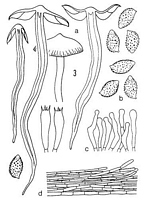
Caption: Phaeocollybia longipes
Hk. (type) a. carpophores. b. spores. c. cheilocystidia. d. cuticle | 
Caption: Phaeocollybia pseudofestiva
Smith (type); f. spores. g. cheilocystidia | 
Caption: Phaeocollybia olivacea Smith (type)
f. cheilocystidia. g. spores. | 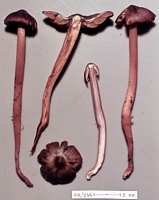
Caption: 68/246: Phaeocollybia longipes
Owner: Egon Horak | 
Caption: scale = 20um. Spores and cheilocystidia.
Owner: J.A. Cooper | 
Owner: J.A. Cooper | 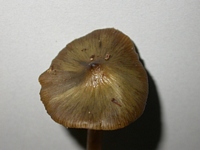
Owner: J.A. Cooper | 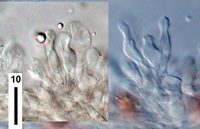
Caption: cheilocystidia
Owner: J.A. Cooper | 
Caption: spores
Owner: J.A. Cooper | 
Caption: Dried type specimen
Owner: Herb PDD | 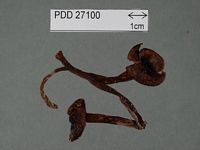
Caption: Dried type specimen
Owner: Herb PDD |
Article: Horak, E. (1973). Fungi Agaricini Novazelandiae I-V. Beihefte zur Nova Hedwigia 43: 200 p.
Description: Pileus
25-50 mm diam., conic becoming broadly conico-umbonate, plane with conspicuous
small umbo in age, olive turning olive-brown at the centre, dark brown towards
the striated margin, viscid when moist, hygrophanous, glabrous. Lamellae adnexed
to subfree, ventricose, pink to reddish-brown turning pallid ferruginous in
age, crowded, gill edge whitish, crenulate. Stipe 100-150 x 4-6 mm, gradually
attenuated towards the base, rooting, brownish, reddish-brown towards the base,
lilac or violaceous colours lacking, dry, glabrous, tough, hollow, rhizoids
absent, single. Context olive in pileus and upper portions of the stipe, fibrillose-stuffed.
Taste and odor fragrant, like burnt hair. Chemical reactions on pileus: KOH
- yellow-brown; HCI and NH3 - negative.
Spores
8-9 x 5-5.5 µm, amygdaliform with a short and blunt beak, distinctly verrucose,
ferruginous. Basidia 26-30 x7-8 µm, 4-spored. Cheilocystidia 22-30 x 2-6 µm,
narrowly clavate, occasionally subcapitate, hyaline, membrane thin-walled abundant
on gill edge. Pleurocystidia absent. Cuticle a cutis consisting of repent, cylindric,
slightly gelatinized hyphae (2-6 µm diam.), encrusted with brownish pigment.
Clamp connections absent.
Habitat: Amongst
Sphagnum in swamp-forest under Nothofagus cliffortioides, Phyllocladus alpinus,
Libocedrus bidwillii etc. New Zealand.
Notes: The
habit and colours of Phaeocollybia longipes remind one of Ph. festiva
(Fr.), Ph. pseudofestiva Smith or Ph. olivacea Smith. However,
the spores of Ph. festiva (Fr.) (within the European-Japanese area of
distribution) are ovoid and not beaked at the ape. Furthermore the spores and
cheilocystidia of Ph. pseudofestiva Smith are distinctly different concerning
size and shape. Finally Ph. olivacea Smith is distinguished by its robust
habit, its glutinous cuticle, the larger strongly beaked spores and the capitate
cheilocystidia
|